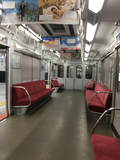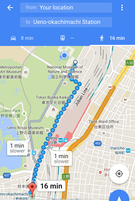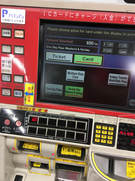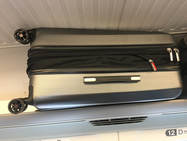Japan is quite large for an island nation and can take time moving from one place to another. The language barrier and geographic size of the large cities can make navigating a challenge. There are a number of tools and resources available to make your journey much easier. Here are some resources and essential tools to bring on your next trip to Japan.
 A Japan Rail line car
A Japan Rail line car
Japan Rail Pass
One benefit available to tourists visiting the country is the Japan Rail Pass. It is a voucher you purchase prior to leaving the United States and bring with you. The pass can be exchanged at a Japan Rail (JR) travel office and is good for either seven or fourteen days depending on which version you buy. You can pay extra for more legroom and better seating found in the green cars. For more detailed information on the restrictions and how to use the Japan Rail Pass, visit the official site. The pass covers the NEX (Narita Express) from Narita Station, Shinkansens (Sakura and Hikaru only), Miyajima Ferry, and other JR lines. It is almost impossible not to get value out of a basic pass for any 7-10 trip to Japan. The average seven day, basic Japan Rail Pass will cost around $257 including shipping. The site recommended, based on experience, to purchase passes is Japan Experience. They ship from France in about a week through FedEx to the United States. Order your passes no later than two weeks in advance of leaving for Japan to ensure delivery. It is highly recommended to purchase a pass as a round trip from Kyoto to Tokyo alone is the cost of the basic Japan Rail Pass. You can exchange passes at any time during your travels. It is not uncommon to visit Tokyo a few days and then exchange a Japan Rail Pass for the remainder of the trip.
One benefit available to tourists visiting the country is the Japan Rail Pass. It is a voucher you purchase prior to leaving the United States and bring with you. The pass can be exchanged at a Japan Rail (JR) travel office and is good for either seven or fourteen days depending on which version you buy. You can pay extra for more legroom and better seating found in the green cars. For more detailed information on the restrictions and how to use the Japan Rail Pass, visit the official site. The pass covers the NEX (Narita Express) from Narita Station, Shinkansens (Sakura and Hikaru only), Miyajima Ferry, and other JR lines. It is almost impossible not to get value out of a basic pass for any 7-10 trip to Japan. The average seven day, basic Japan Rail Pass will cost around $257 including shipping. The site recommended, based on experience, to purchase passes is Japan Experience. They ship from France in about a week through FedEx to the United States. Order your passes no later than two weeks in advance of leaving for Japan to ensure delivery. It is highly recommended to purchase a pass as a round trip from Kyoto to Tokyo alone is the cost of the basic Japan Rail Pass. You can exchange passes at any time during your travels. It is not uncommon to visit Tokyo a few days and then exchange a Japan Rail Pass for the remainder of the trip.
 Walking to Ueno Station
Walking to Ueno Station
Rent a Pocket WiFi / SIM card / Cell Phone
Japan can be a challenge to find specific shops, restaurants, bars, or even hotels in major cities. One rule of thumb is to always look up as many places are not on ground level. Having access to Google Maps and other navigation apps is critical. It is highly recommended to rent a Pocket WiFi, SIM card, or a cell phone capable of internet access. The recommendation, based on experience, is to rent a device and have it available for pickup at the Japan Post Office located in the Airport Terminal of your arrival flight. A reputable site to rent multiple devices from is Global Advanced Communications. They make it very easy to rent and pickup any device you need at affordable prices. There are options to rent equipment at the airport, but the prices will overall be more expensive. When you depart from the airport, just drop off the return envelop with the equipment into any red Japan Post mailbox before entering the security line to the flight gates.
Japan can be a challenge to find specific shops, restaurants, bars, or even hotels in major cities. One rule of thumb is to always look up as many places are not on ground level. Having access to Google Maps and other navigation apps is critical. It is highly recommended to rent a Pocket WiFi, SIM card, or a cell phone capable of internet access. The recommendation, based on experience, is to rent a device and have it available for pickup at the Japan Post Office located in the Airport Terminal of your arrival flight. A reputable site to rent multiple devices from is Global Advanced Communications. They make it very easy to rent and pickup any device you need at affordable prices. There are options to rent equipment at the airport, but the prices will overall be more expensive. When you depart from the airport, just drop off the return envelop with the equipment into any red Japan Post mailbox before entering the security line to the flight gates.
 Put the money in first
Put the money in first
Subway / Metro Access
In major cities such as Osaka and Tokyo, the subway system is your best method of transportation. The subway maps are quite overwhelming with multiple lines, routes, and entrances. The maze of underground hallways is very extensive. Fortunately, signs are in English overhead assisting where to go and maps above ticket machines tell you stops and prices for tickets. You can purchase one day passes to make things easier. Make sure you put in money first before pressing any buttons. The ticket machines have an English option easier operating. Tokyo Metro has an app available for free on Google Play and the App Store that is highly recommended. There are other third party apps available for metro navigation in multiple cities, but you may find them lacking. It is recommended to use Google Maps or a phone app to plan out subway routes.
In major cities such as Osaka and Tokyo, the subway system is your best method of transportation. The subway maps are quite overwhelming with multiple lines, routes, and entrances. The maze of underground hallways is very extensive. Fortunately, signs are in English overhead assisting where to go and maps above ticket machines tell you stops and prices for tickets. You can purchase one day passes to make things easier. Make sure you put in money first before pressing any buttons. The ticket machines have an English option easier operating. Tokyo Metro has an app available for free on Google Play and the App Store that is highly recommended. There are other third party apps available for metro navigation in multiple cities, but you may find them lacking. It is recommended to use Google Maps or a phone app to plan out subway routes.
 Bring luggage that can fit in small spaces
Bring luggage that can fit in small spaces
Do Not Over Pack
When traveling around Japan, expect small hotel rooms, compact cars, overcrowded subway cars, and tight spaces. One of the biggest travel mistakes is bringing too much luggage. It can be quite difficult navigating subway tunnels, rail lines, and maneuvering sidewalks with multiple rolling suitcases or heavy bags. Many hotel rooms are very small with minimal storage space. Trains are not equipped to handle large pieces of luggage. Try to bring a suitcase that is 25 inches tall and under. The reason is that once you expand the luggage through the side zippers, it may not fit in overhead compartments on Shinkansen trains. There is a small area of space behind the last row in the back of each car for over-sized luggage, but nothing else. You may see people sitting with their luggage under their legs because it is too large to fit in the above area. The NEX has lockable luggage storage at the end of each car, but it is very limited. Japan has luggage courier services to transport items from one hotel or place to another. This is something that usually needs a reservation ahead of time. JAL ABC and Takkyubin are luggage couriers available at airport terminals. Finally, save space in your luggage to bring back wonderful souvenirs.
When traveling around Japan, expect small hotel rooms, compact cars, overcrowded subway cars, and tight spaces. One of the biggest travel mistakes is bringing too much luggage. It can be quite difficult navigating subway tunnels, rail lines, and maneuvering sidewalks with multiple rolling suitcases or heavy bags. Many hotel rooms are very small with minimal storage space. Trains are not equipped to handle large pieces of luggage. Try to bring a suitcase that is 25 inches tall and under. The reason is that once you expand the luggage through the side zippers, it may not fit in overhead compartments on Shinkansen trains. There is a small area of space behind the last row in the back of each car for over-sized luggage, but nothing else. You may see people sitting with their luggage under their legs because it is too large to fit in the above area. The NEX has lockable luggage storage at the end of each car, but it is very limited. Japan has luggage courier services to transport items from one hotel or place to another. This is something that usually needs a reservation ahead of time. JAL ABC and Takkyubin are luggage couriers available at airport terminals. Finally, save space in your luggage to bring back wonderful souvenirs.